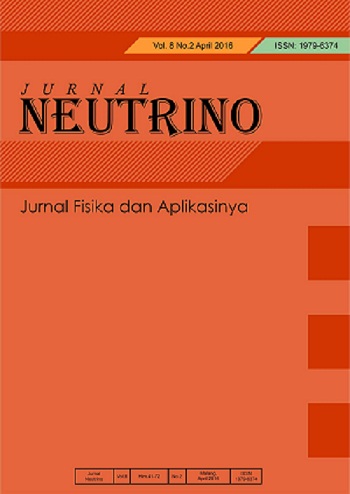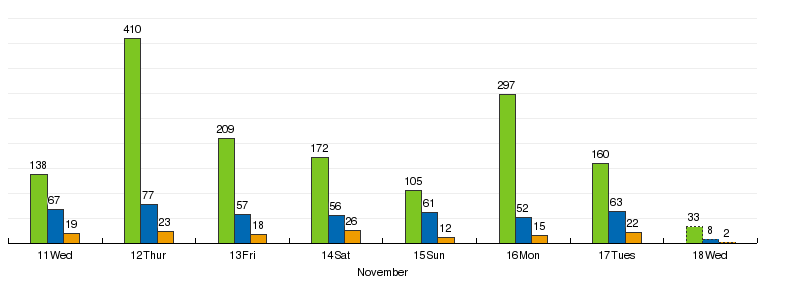THERMOACOUSTIC REFRIGERATOR SYSTEM PERFORMANCE USING THE PVC (POLYVINYL CHLORIDE) STACK BY POWER INPUT VARIATION
Abstract
The thermoacoustic refrigerator is an innovative alternative and did not use substances that had a negative impact on the environment such as freon, but using air as the working substance. The materials used the refrigerator were easily obtained and the construction components were simple so that made this refrigerator was cheap, easy to make and easy to maintain. Stack was used in the thermoacoustic refrigerator system used PVC (Polyvinyl chloride) which is parallel cylindrical shape and diameter (1.50 ± 0.05) mm and length of 8 cm. Variations of loudspeaker input power that used were 20 watt, 30 watt, 40 watt, 50 watt and 60 watt. Variations of the input power that used to determine the effect of loudspeaker input power to decreasing temperature in the operating of the thermoacoustic refrigerator system using PVC stack. From the result, loudspeaker input power influenced on the decreasing temperature that was 6.0 °C for 20 watts, 6.7 °C for 30 watts, 7.2 °C for 40 watts, 8.0 °C for 50 watts and 9.0 °C for 60 watts. From these results indicated optimum decreasing temperature depended on the amount of loudspeaker power that was directly proportional to the decreasing temperature obtained.
Keywords
Full Text:
PDFReferences
Jaworski AJ, Mao X. Development of thermoacoustic devices for power generation and refrigeration. Journal Power and Energy [Internet]. 2014 July [cited 2017 Feb 28];227(7):762-782. Available from:http://journals.sagepub.com/doi/pdf/10.1177/0957650913493622
Marx D, Mao X, Jaworski AJ. Acoustic coupling between the loudspeaker and the resonator in a standing-wave thermoacoustic device. Applied Acoustics. 2006:67(5):402-419. doi:10.1016/j.apacoust.2005.08.001
Panara KS, Patel AM, Patel NS, Patel JD. Thermoacoustic Refrigeration System Setup. International Journal of Mechanical Engineering and Technology (IJMET) [Internet]. 2015 Nov [cited 2017 Feb 24];6(11):1-15. Available from: http://www.iaeme.com/MasterAdmin/UploadFolder/IJMET_06_11_001/IJMET_06_11_001.pdf
Tang K, Chen GB, Jin T, Bao R, Kong B, Qiu LM. Influence of resonance tube length on performance of thermoacousically driven pulse tube refrigerator. Elsevier International Journal of Cryogenics. 2005:45(3):185-191. doi:10.1016/j.cryogenics.2004.10.00
Tijani MEH, Zeegers JCH, De Waele ATAM. Design of Thermoacoustic Refrigerators. Elsevier International Journal of Cryogenics. 2002:42(1):49-57. doi:10.1016/S0011-2275(01)00179-5
Ghazali NM, Anwar M, Settar NH. Thermoacoustic Cooling with No Refrigerant. International Journal of Technology [Internet]. 2011 [cited 2017 Feb 25]:2(3):234-241. Available from: http://www.ijtech.eng.ui.ac.id/index.php/journal/article/view/72
Russell DA, Weibull P. Tabletop Thermoacoacoustic Refrigerator for Demonstrations. American Journal of Physics. 2002:70(12):1231-1233. doi:10.1119/1.1485720
Nsofor EC, Celik S, Wang X. Experimental Study On the Heat Transfer at the Heat Exchanger of the Thermoacoustic Refrigerating System. 2007:27(14-15):2435-2442. doi:10.1016/j.applthermaleng.2007.03.008
DOI: https://doi.org/10.18860/neu.v9i2.4073
Refbacks
- There are currently no refbacks.
Copyright (c) 2017 Indah Kharismawati

This work is licensed under a Creative Commons Attribution-NonCommercial-ShareAlike 4.0 International License.
Published By:
Jurusan Fisika Fakultas Sains dan Teknologi Universitas Islam Negeri (UIN) Maulana Malik Ibrahim Malang, Indonesia
B.J. Habibie 2nd Floor
Jl. Gajayana No.50 Malang 65144
Telp./Fax.: (0341) 558933
Email: neutrino@uin-malang.ac.id
This work is licensed under a Creative Commons Attribution-NonCommercial-ShareAlike 4.0 International License










